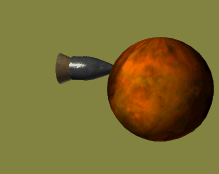 Foundation
Foundation
Along with his Robot stories, the Foundation sequence is Asimov's most famous work. An important part of understanding the original Foundation trilogy is to note that they were originally written and published as a series of individual novellas in the Science Fiction Magazines of the early 40s and this structure is maintained within the books. It consists of (in published order):
There is a series from the pens of Gregory Benford, Greg Bear and David Brin (AKA the Three Bs) expanding the Foundation Universe, though in my humble opinion the best non-Asimov story set in this universe is 'The Originist' by Orson Scott Card published in the collection Foundation's Friends (IMHO, this is also one of OSC's best pieces), though Harry Turtledove's story of the sacking of Trantor, 'Trantor Falls', in the same collection, runs it a very close second, depending on mood.
A nice sideways look at the Foundation Universe post the creation of the Second Empire can be found in Donald Kingsbury's non-canonical Psychohistorical Crisis - not officially part of the Foundationverse but it is fairly obvious where Mr Kingsbury got his inspiration.
Apart from the Foundation books, Dr Asimov is probably best known for the series of Robot stories he wrote. These include numerous short stories and a number of novels, the best known of which are the Lije Bailey/Daneel Olivaw set. These are in order of memory :-):
The Caves of Steel We are introduced to Lije Bailey and the warrens of Earth.
The Naked Sun Lije and Daneel travel to the Spacer World of Solaris to investigate a murder...
The Robots of Dawn Lije finally gets to see what life's like on Aurora
Robots and Empire Many years after Lije's death, Daneel has to find a way of stopping Spacer hatreds from destroying Earth.
There are a number of other series set at various points in the above sequence of books; the Robot City books, by various authors, which seem to fit in between The Robots of Dawn and Robots and Empire: Earth is beginning to break out of it's shell, but the Spacers are still powerful and there are Settler worlds. Roger McBride Allen's 'Caliban' trilogy is set after Robots and Empire; there are still Spacer worlds, though their powers seem much reduced and Earth is spoken of in the past tense.
As well as these (more or less) consistent series, Dr Asimov has written a trio of novels that are based within a relatively consistent story arc from a time from before the Empire was formed through to the early years of the Empire. These stories are not really connected in any serious fashion to either themselves or the 'Foundation' or Robot books. Earth is radio-active in these books though the clear implication is that this caused by a war occuring at an unspecified time in Asimov's future. This had to be heavily modified in the later novels to bring it into line with Real History as it became obvious that we weren't about to anhilate ourselves in a nuclear holocaust. These are generally known as the 'Empire' novels (in story order);
Sadly he was not spared to develop his view of the future after the Foundation. His death was noted throughout the world in recognition of his contributions to the dissemination of science, the codification of the Three Laws of Robotics and his eminence as one of the three Grand Masters of Science Fiction.
The Complete Robot contains most of the short Robot Stories that are based on the Three Laws of Robotics (there are two which are fairly border-line - 'The Bicentennial Robot' and '...That Thou Art Mindful of Him' where the robots are able to redefine what Humanity is, though the robots in both stories are bound by the three laws). As such, they are mainly technical adventure stories - why did robot CL5 behave in the way it did, rather than Robot smashes it's way through the Solar System needing to be stopped.
If you have read many of his works, including the short stories that make up such a large part of his work you might notice the lack of aliens. There is a short story, "Blind Alley" set in the Galactic Empire milieu where an alien species is given another chance through manipulation of the Imperial bureaucracy. There are also a number of other short stories set in a consistent background where Terra is a relatively minor part of the background. This Federation is held together by psychological manipulation, though rather more overt than the Psychohistory of Hari Seldon <G>. There are also the lizard-like occupiers of Earth in "Black Friar of the Flame" which would appear to have a similar background to the Galactic Empire stories, except the concept of aliens is totally foreign to the Empire.
This lack of aliens is not really an indication that Asimov was unable to write convincingly alien aliens, but more to do with the requirement of publishing. Most of his short stories were published in the magazines of John Campbell Jnr. who had fixed views on the transcendental abilities of Earthmen to beat the aliens from the stars. Dr Asimov felt that it would be extremely unlikely that Humanity would be in a position where such a thing would be possible, i.e. if aliens do exist they are as likely to be far far more advanced than Humanity as far less advanced - think of it as a continuum.
Don't forget that these books are offered for sale through the Amazon.com and Amazon.co.uk affiliates programme.
For more information on Dr Asimov click here
And for more books by Dr Asimov click here!
Document:
Last Update: